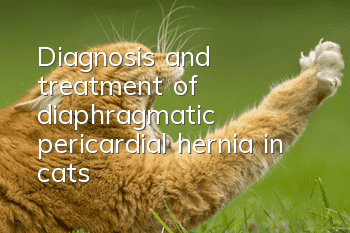Diagnosis and treatment of diaphragmatic pericardial hernia in cats!

Heart disease is more common in middle-aged and older cats
Many heart diseases in cats are caused by congenital factors. Of course, some are caused by later feeding. Heart disease usually occurs when cats are young. It is not advisable to realize that symptoms of heart disease will gradually appear when you are approaching old age. Different physical differences will produce various different symptoms, and septal hernia can also cause heart disease.
The so-called septal hernia refers to a congenital defect in the diaphragm that separates the chest and abdominal cavities, through which the stomach or intestines enter the chest. The most common is a defect on the right back side. The stomach or intestines enter the chest. The intestines compress the lungs, making it difficult to breathe.
Peritoneal pericardial sac and diaphragmatic hernia are the most common congenital pericardial malformations in cats. It is abnormal embryonic development that results in the persistence of pericardial-abdominal communication in the midline of the abdomen and is associated with a number of congenital developmental anomalies such as sternal malformations (especially in cats), anterior abdominal hernias, and ventricular septal defects. Persian cats have a breed susceptibility, with males being more susceptible than females.
The clinical symptoms of peritoneal pericardial sac and diaphragmatic hernia depend on the nature and volume of the herniated abdominal contents. Some sick animals do not have any clinical symptoms, and PPDH is diagnosed by physical examination. Animals with symptoms usually have gastrointestinal or respiratory symptoms: vomiting, diarrhea, anorexia, weight loss, abdominal pain, coughing, difficulty breathing, mostly due to a large number of abdominal viscera compressing the heart or lungs and abdominal viscera (such as liver and small intestine). caused by closure.
The diagnosis by X-ray examination depends on the size of the defect and the volume of the herniated abdominal contents. Specific diagnostic findings include enlargement of the heart outline, dorsal displacement of the trachea, and overlap of the diaphragm shadow and the posterior edge of the heart. , abnormal fat and/or gas density images within the cardiac contour. Abdominal X-ray images are empty. For cases that are difficult to diagnose with ordinary X-ray examination, X-ray angiography can be used to evaluate the diaphragm. The diaphragm can be comprehensively evaluated by injecting a water-soluble positive contrast agent into the abdominal cavity at a dose of 1 to 2 ml/kg, and then taking right, left, dorsal and ventral X-rays. The presence of contrast material in the chest confirms the diagnosis of diaphragmatic rupture. A barium meal image shows the bowel across the diaphragm and into the pericardial sac. Echocardiography is helpful in confirming the diagnosis of suspected animals and can detect abnormal organ images in the pericardium.
Surgical treatment is the best option in this case. The hernia content is reduced and the hernia ring is closed surgically. The success rate of the operation is usually relatively high. Conservative treatment is also an option for animals without clinical symptoms.
- What should I do if my cat loses hair in spring?
- Can cats eat pepper?
- What are the benefits of supplementing protein for cats? Novice cat owners!
- Do kittens meow when they are born?
- Why does my cat have a runny nose?
- What to do if a kitten eats cat litter
- What are the side effects of lactulose for cats with constipation?
- What are the cat training techniques? A must-read for every poop scooper!
- What should I do if my cat is too greedy?
- Communication with cats is more important than training, so that you can get along with cats better!



